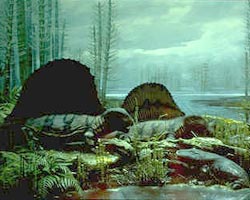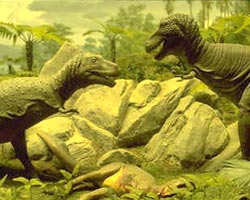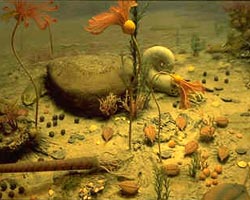| Site Map | Contacts | Links | Newsletter | |
Homeschool:
Geology
There are three main ERA's of geological history. Starting with the oldest:
Paleozoic
There are seven different periods in the Paleozoic era. Starting with the oldest they are:
Cambrian - Age of Trilobites
Abundant growth of life mainly invertebrates in shallow warm seas. Trilobites dominated the seas along with shells, brachiopods. There was no freshwater or land organisms. Green, Blue-green, and red algae were the main marine plants that formed massive structures called stromatolites. The continents were Gondwanaland (which was the combination of Africa, South America, Australia, and Antarctica) Baltica, Siberia, and Laurentia (North America and Greenland) which were mainly spread across the equator. Much of the early work on the Paleozoic was done in Wales which is reflected in the names of some periods. Cambria (Latin) was the ancient name for Wales. Many carbonate rocks rocks like limestone and chalk formed.
The best place to find fossils of the Cambrian period is in the Burgess Shale in Walcott Quarry in Yoho National Park in British Columbia. The following link has some very interesting pictures of the very strange animals found in the Burgess Shale.
Ordovician - Age of Cephalopods
The Ordovician period is named after rock formations in North Wales formerly inhabited by a Celtic tribe named Ordovices. The first land and fresh water plants, and vertebrates appear. The Taconic Mountains of New York Sate start to form called the Taconian Orogeny. Orogeny means "mountain-building" episode. Graptolites are used as zone fossils of this period. Many carbonate rocks and some sandstones were formed during this period.
Silurian - Age of Coral
The Silurian Period is named after an ancient tribe of the Walsh borderland called Silures. The major mountain-building event of the Silurian was the Caledonian Orogeny forming the Cledonian mountains of northeast North America and northwest Europe. Most of the rocks formed were carbonate. In the middle Silurian the first coral reefs appear, and by the late Silurian evaporites appear in the United States. There are many brachiopods, crinoids, and corals. In Australia two important land plants, the lycopsids and the psilopsids, are found.
Devonian - Age of Fishes
During the Devonian period huge amounts of red sandstones were deposited over large areas named Old Red Sandstones in the basins between the Caledonian mountains. Iron, zinc, tin, and copper can be found in them. The red color is from iron oxide. There are also green, and gray sandstones. This is the age of fish. There are armored fish, jawless fish, bony fish, air-breathing fish, and sharks.
Mississippian - Age of Crinoids
In Europe this period is called the Lower Carboniferous while in America it is called the Mississippian. There were three major continents at this time: Gondwanaland, Laurentia, and Angaraland (Asiatic Russia, Siberia, and parts of China). Limestones thousands of meters deep formed in shallow warm seas as a result of Laurentia and Gondwanaland drifting closer together. Limestone is formed by the the shells and skeletons of millions of marine organisms.

Pennsylvanian - Age of Plants and Giant Insects
Huge coastal swamp forests thrived, were buried, and formed layers of coal. In Pennsylvania this period is over 4,000 feet thick in some places from which it gets its name. In Europe it is called the Upper Carboniferous. There were huge insects like the Meganeura, dragonfly that had a wingspan of one and one-half feet. Gondwanaland and Luarentia collide to form the Appalachian Mountains and shallowing the Tethys Sea.
Permian - Age of Amphibians
The Permian period is named after the area around the town of Perm in Russia. The end of the Permian is marked by mass extinction. 90 percent of marine life became extinct. The environment was probably hot and arid. Rocks called New Red Sandstones formed. The continents all came together to form Pangaea. The Southern part of the continent is frozen by huge ice sheets.
Mesozoic - Age of Dinosaurs

The Mesozoic is the age of dinosaurs. It is divided up into three periods: Triassic, Jurassic, and Cretaceous.
Triassic
It is named after the threefold rock formation in Germany.
Jurassic
The Jurassic period is named after the rock formation in the Jura mountains that border Switzerland and France. Pangaea starts to break apart in this period.
Cretaceous
The Cretaceous period is named after its characteristic rock, chalk which is "creta" in Latin. Warm shallow seas spread over many of the continents. Sea level rose 650 feet because the warm climate melted all the ice sheets. The end is marked by mass extinction of the dinosaurs.
Cenozoic
This era is divided into two periods: the Tertiary and Quaternary. The Tertiary is also divided into the Paleogene and Neogene.
Tertiary - Age of Mammals
The Tertiary period saw the rise of mammals. It is divided into five epochs: Paleoceno, Eocene, Oligocene, Miocene, Pliocene.
Quaternary
The Quaternary is the age of man. It is divided into two epochs: the Pleistocene, and Holocene.
Projects
- Start a rock collection. Try to find the three basic types of rock: Sedimentary, Igneous, and Metamorphic.
- Start a fossil collection.
- Draw your own geologic Column. See a nice chart of the Geological Time Scale.
Field Trips
Take a field trip with your family to find some interesting rocks and fossils. Here are some key places within three hours of Philadelphia.
- Franklin Mineral Museum in Franklin, NJ. Here you can find world famous fluorescent rocks.
- At Deer Lake, PA you can find marine fossils from the Devonian period like trilobites, and brachiopods.
- Calvert Cliffs, MD. Along the beaches you can find shark's teeth.
More detailed information on fieldtrips for the family.

